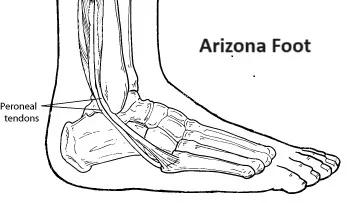What Are the Peroneal Tendons?
To fully understand peroneal tendon injuries, comprehending the function of peroneal tendons is crucial. Tendons are tissues that link muscles to bones.  Located behind the outer ankle bone, the foot has two peroneal tendons running parallel to each other. One tendon connects to the outside of the midfoot, and the other runs beneath the foot, attaching close to the inner arch. These tendons help stabilize the foot and ankle, safeguarding them against sprains.
Located behind the outer ankle bone, the foot has two peroneal tendons running parallel to each other. One tendon connects to the outside of the midfoot, and the other runs beneath the foot, attaching close to the inner arch. These tendons help stabilize the foot and ankle, safeguarding them against sprains.
Causes & Symptoms of Peroneal Tendon Injuries
These injuries can be either acute, arising abruptly, or chronic, developing over time. Those involved in sports with recurrent ankle movement are more likely to experience these injuries. Likewise, individuals with higher arches may be predisposed to peroneal tendon issues. Tendonitis, tears, and subluxation are common types of peroneal tendon injuries.
Personal Tendonitis
Tendonitis is the inflammation of one or both tendons due to repetitive use, overuse, or trauma from incidents like ankle sprains. The primary symptoms of tendonitis include:
- Pain
- Swelling
- A warm sensation on the touch
Acute Tears
Caused by repeated activity or trauma, acute tears lead to:
- Pain
- Swelling
- Foot and ankle weakness or instability
Over time, these tears may result in higher foot arches.
Degenerative Tears (Tendonosis)
These tears gradually occur from overuse over long periods and are common in individuals with high arches. The tendon becomes overstretched, thin, and eventually frayed. Symptoms may include:
- Intermittent (on-and-off) pain on the outer ankle
- Ankle weakness or instability
- Increased arch height
Subluxation
Subluxation describes tendons that have shifted out of place. Congenital bone or muscle shape differences, or trauma, such as ankle sprains, can cause this. Damage to the stabilizing tissues (retinaculum) can lead to ongoing tendon subluxation. Symptoms include:
- A snapping sensation around the ankle bone
- Occasional pain behind the outside ankle bone
- Ankle weakness or instability
Immediate treatment of subluxation is vital to avoid further damage, like tears or ruptures. If you notice a snapping, consult a foot and ankle surgeon right away.
Diagnosis of Peroneal Tendon Injuries
Because these injuries can be incorrectly diagnosed and may progress without correct treatment, an early examination by a foot and ankle surgeon is important. For diagnosis, the surgeon will check for pain, instability, swelling, warmth, and weakness on the ankle’s outer side. X-rays or other advanced imaging may be necessary to thoroughly assess the injury. The surgeon will also look for signs of an ankle sprain or other associated injuries.
Nonsurgical Treatment
The treatment will vary based on the injury type. Nonsurgical options include:
- Immobilization: Using a cast or splint to immobilize the area helps the injury heal.
- Medications: Anti-inflammatory drugs can aid in reducing pain and inflammation.
- Physical therapy: Heat, ice, or ultrasound treatments help decrease swelling and pain. Exercises can be introduced to boost muscle strength, balance, and range of motion.
- Bracing: The surgeon might recommend a temporary brace, especially during activities that involve repetitive ankle motion.
When Is Surgery Needed?
Some situations necessitate surgical intervention to mend the affected tendons and possibly the foot’s supporting structures. The foot and ankle surgeon will determine the most suitable surgical approach based on the patient’s case and lifestyle. Post-surgery, physical therapy plays a key role in recovery.
Why Choose a Foot and Ankle Surgeon?
Foot and ankle surgeons are at the forefront of foot and ankle care. Known as podiatrists or DPMs, these experts have extensive education and training focused on the foot and ankle—greater than any other healthcare professional. Their comprehensive training enables them to conduct a wide variety of surgeries, including those that may be required for peroneal tendon injuries. Foot and ankle surgeons handle all conditions related to the foot and ankle in patients of all ages, ensuring comprehensive care for issues such as peroneal tendon injuries, peroneal tendon pain, and outer foot pain.



